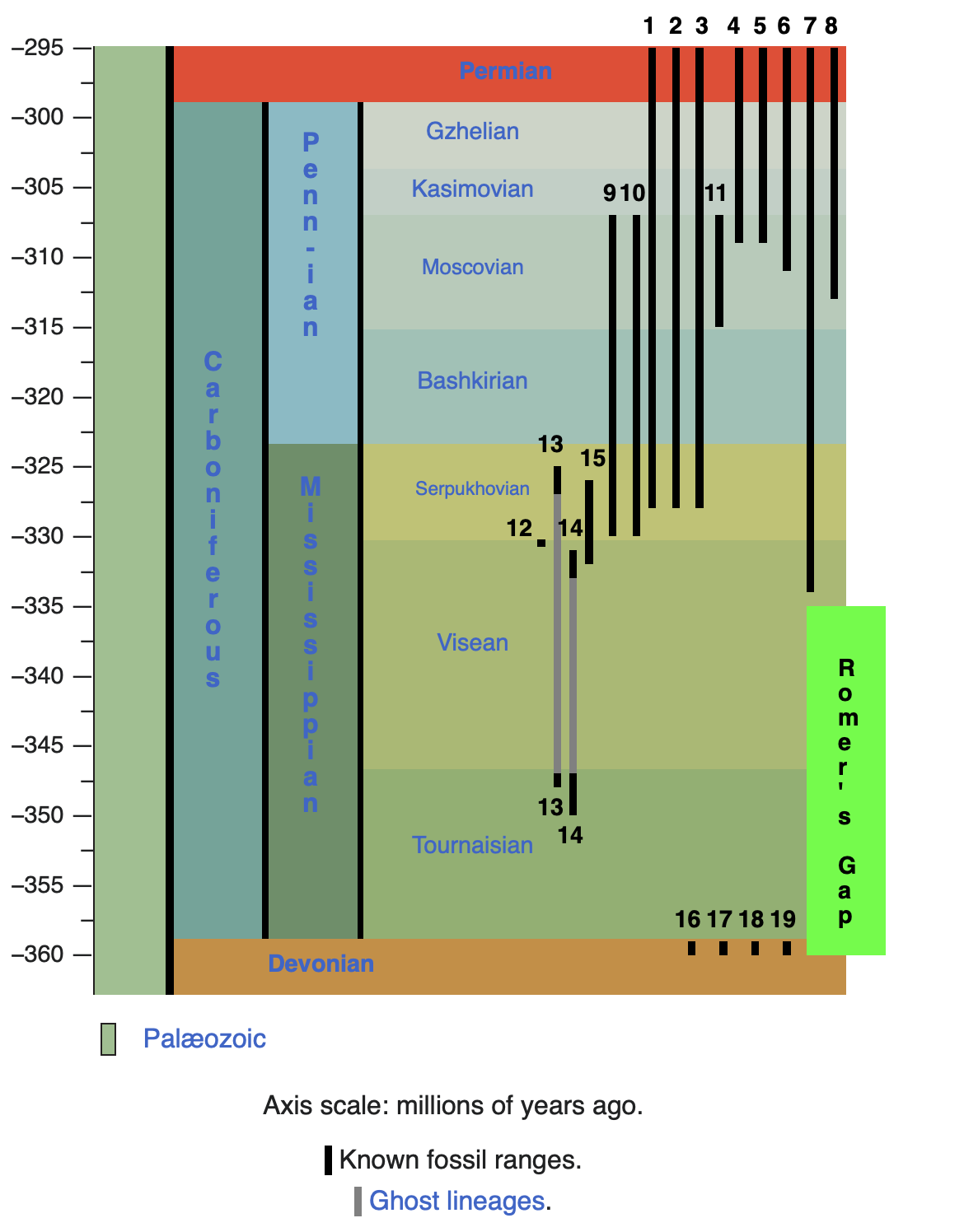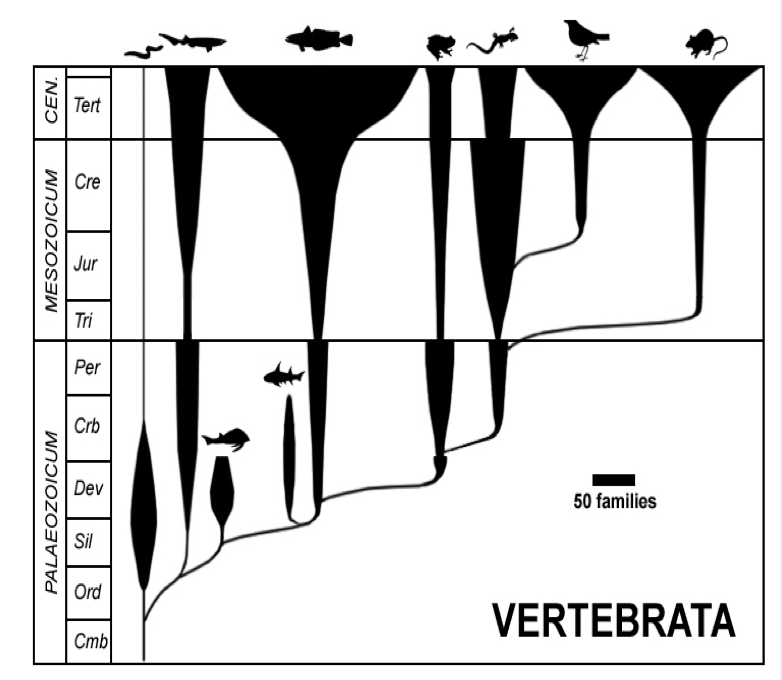Paleontologists 2 - Finding Fossils
1/37
There's no tags or description
Looks like no tags are added yet.
Name | Mastery | Learn | Test | Matching | Spaced |
|---|
No study sessions yet.
38 Terms
false (1832)
Cuvier died in 1847.
Name a major paleontological contribution that Cuvier made (that we went over).
(all of the following have to do w/ paleontology)
provided a lot of evidence for extinction
reconstructions of extinct lifeforms
1st scientist to publish work about a flying reptile (a pterosaur)
provided scientific evidence to back up catastrophism
work w/ rock strata helped w/ principle of faunal succession
Alfred Romer
Born: 1894
White Plains, NY
Harry Houston Romer & Evalyn Sherwood
Wife: Ruth Hibbard
Died: 1973
Cambridge, Mass.
Romer education
White Plains HS
BS: Biology degree at Amherst College
M.Sc & PhD: Zoology degrees at Columbia University
Romer positions
Instructor of Anatomy at Bellevue Hospital Medical College in NYC
Associate professor at University of Chicago, Dept. of Geology & Paleontology (1923)
Professor of Biology at Harvard University (1934)
Director of Harvard Museum of Comparative Zoology (1946)
Romer societies
1st president of the Society of Vertebrate Paleontology
National Academy of Science
Foreign Member of the Royal Society
Romer awards
Mary Clark Thompson Medal
Daniel Giraud Elliot Medal
Hayden Memorial Geological Award
Penrose Medal
Paleontological Society Medal
Linnean Medal
Golden Plate Award of the American Academy of Achievement
Wollaston Medal
Romer contributions pt. 1
leading contributor of vertebrate paleontology throughout much of 20th century
founder & 1st president of the Society of Vertebrate Paleontology
textbook — Vertebrate Paleontology
educator at all levels
public presentations, classroom lectures, & supervisor of >25 graduate students
Romer contributions pt. 2
ancestry of vertebrates, Paleozoic tetrapods, & antecedents of mammals
united the entire discipline w/ his concepts, textbooks, & general understanding
books:
The Vertebrate Body (in six editions)
Osteology of the Reptiles
major reviews of labyrinthodonts & pelycosaurs
provided the highest standards that we can hope to follow in the profession of vert. paleo.
Romer taxonomic patronyms
Romeriida — a clade that contains the diapsids & their closest relatives
Romeria — a genus of early captorhinids
Romeriscus — a genus from early Pennsylvanian (Late Carboniferous) initially described as the oldest known amniote
Romer’s Gap
1st to recognize the gap in the fossil record b/t tetrapods of the Devonian & later Carboniferous period

Romerogram
aka spindle/bubble diagram:
represents taxonomic diversity (horizontal width) against geological time (vertical axis) in order to reflect the variation of abundance of various taxa through time

George Gaylord Simpson
Born: 1902
Chicago, IL
Joseph & Helen Simpson (2 older sisters)
wife 1: Lydia Pedroja (divorced in 1938)
had 4 daughters
wife 2: Anne Roe
Died: 1984
Tuscon, AZ
Simpson education
Denver HS
B.A.: University of Colorado until senior year, then transferred to Yale (graduating in 1923)
PhD: Yale University (1926)
Simpson positions
Staff at American Museum of Natural History (1927)
Captain & Major in U.S. Army during WW2 (Intelligence)
Curator of Paleontology at American Museum of Natural History after WW2 (1945)
Professor at Columbia University (1945)
Professor of Vertebrate Paleontology at Harvard Museum of Comparative Anatomy (1958-59)
Professor of Geosciences at University of Arizona (1968-1982)
Simpson societies
1st elected president of Society of Vertebrate Paleontology
1st president of Society for the Study of Evolution
American Philosophical Society National Academy of Science
American Academy of Arts & Sciences
Foreign Member of Royal Society
Simpson awards
same as Romer:
Mary Clark Thompson Medal
Daniel Giraud Elliot Medal (twice)
Hayden Memorial Geological Award
Penrose Medal
Paleontological Society Medal
Linnean Medal
Golden Plate Award of the American Academy of Achievement
different:
Darwin-Wallace Medal
Darwin Medal
National Medal of Science
Simpson contributions
major participant in the modern synthesis
Tempo and Mode in Evolution (1944)
The Meaning of Evolution (1949)
The Major Features of Evolution (1953)
expert on extinct mammals & their intercontinental migrations
Mesozoic/N&S America fossil mammals
anticipated punctuated equilibrium concept & dispelled myth of linear horse evolution
coined the word “hypodigm” in 1940 & published extensively on the taxonomy of fossil & extant mammals
influentially & incorrectly opposed to Alfred Wegener's theory of continental drift, but accepted the theory of plate tectonics (& continental drift)
when evidence became conclusive
Simpson contributions to paleontology
(hint: paleontology)
monographed Marsh’s magnificent Mesozoic mammals from Como Bluff & elsewhere
produced a companion monograph of the British Mesozoic Mammalia
illuminate the beginning of the age of mammals
produced a massive replication replete w/ insightful footnotes & philosophical explanations
vibrant style of writing on all kinds of subjects
Simpson books
Quantitative Zoology (1944)
Horses (1951)
Penguins (1976)
true
Cuvier helped establish the field of comparative anatomy a lot.
false
Cuvier believed in the theory of evolution.
false
Mary Anning never had a formal education and was illiterate.
Name a major contribution that Mary Anning made to paleontology.
associated w/…
1st Ichthyosaur
1st Plesiosaur
1st Pterosaur outside of Germany
pioneered study of coprolites
inspired public interest in geology/paleontology
Blaire Van Valkenburgh
Born: 1952 (still alive!)
Washington, D.C.
raised in Alexandria, VA
Mother: Lois Van Valkenburgh
Van Valkenburgh education
T. C. Williams HS
B.S.: from Stockton University!
M.A., PhD, & postdoc: Johns Hopkins University
Vertebrate Paleontology
worked w/ Alan Walker
Van Valkenburgh positions
Associate Dean of Academic Programs in the Life Sciences, UCLA (2011-present)
Curator, Donald R. Dickey Collection of Birds and Mammals, UCLA (1986-present)
Professor, Department of Ecology and Evolutionary Biology, UCLA (1995-present)
Van Valkenburgh societies
was President & VP of Society of Vertebrate Paleontology:
Donald R. Dickey Chair in Vertebrate Biology (endowed professorship)
Phi Beta Kappa Visiting Scholar
Elected Fellow of the Paleontological Society
Honorary Fellow, California Academy of Sciences
Predoctoral Fellow, American Association of University Women
Gilman Fellowship, The Johns Hopkins University
Van Valkenburgh awards
Romer-Simpson Medal, Society of Vertebrate Paleontology
Van Valkenburgh research interests
evolution of form, function, & ecology in organisms, both living/extinct
focused on large predatory mammals
explored the fossil record of carnivores from both ecological & evolutionary perspectives
Van Valkenburgh recent interests
parallels b/t past & present predator guilds
evolution of mammalian feeding adaptations
function & evolution of mammalian nasal turbinate bones
molecular & morphological evolution w/in the Carnivora
Van Valkenburgh contributions
>110 publications in biology & paleontology of carnivorous mammals
appearance on TV documentaries on prehistoric predators
a leading expert on evolutionary biology of large carnivores (past & present)
Curator of Donald R. Dickey Collection of Birds & Mammals at UCLA
professor, mentor/advisor, colleague, to many past & present biologists/paleontologists
Van Valkenburgh publications
2018:
Anatomy of STEM teaching in North American universities
History of the cheetah-human relationship
The cheetah: evolutionary history and paleoecology
true
It is legal to collect & sell fossils that are found on privately owned properly in the US, if they are NOT associated w/ Native American culture artifacts/burial sites.
parachute science
wealthy people/scientists (focused on Caucasian people from Europe & US):
going to foreign places & assuming they know best
native people couldn’t know as much
led to not including native people w/ scientific endeavors, taking resources perhaps, & even skirting local laws and/or breaking them
false (Myanmar)
Dr. Lewis focused on the Dominican Republic when she discussed “blood amber”
Germany
Which country did Dr. Lewis say has had some issues w/ taking & keeping fossils from other places & having them in personal collections?
Why do countries like Ethiopia & Kenya seem to value fossils more than countries like the US & consider them part of their national heritage?
really feel the fossils/know them
they’ve been a part of their past/history for a long time
may be more well versed in paleontology & evolution as well